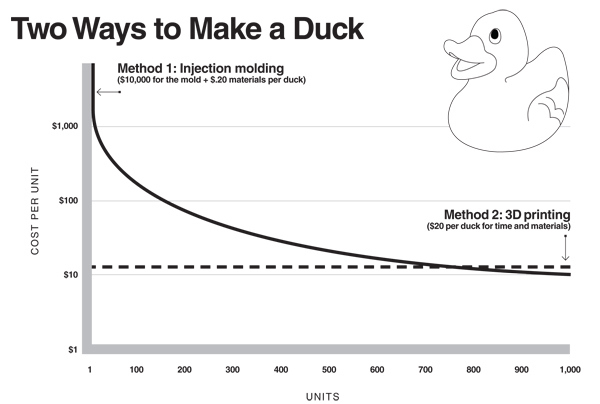Hi All,
I have a smart toy product with about 13 different parts. I am doing a cost comparison of doing a plastic mold for all 13 parts vs doing 3d printing for all of them.
I dont see any options related to 3D printing for volume production where you could assemble say 5000 products with just 3d printing. Is volume manufacturing practical with 3d printing.
2 Likes
cobnut
2
Hi @omniengr the answer to your question is almost always going to be “no”. In most cases, 3D printing is best suited to prototyping, unique creations or short runs of final product. Once you start looking at production runs in the hundreds, and certainly when you’re talking about thousands, other methods of production become much more cost efficient.
1 Like
Also the 3d printed will not be as strong or look as nice as a molded part. Depending on the use you do not want a toy that could break in to small parts and become a hazard.
7 Likes
3DMuse
4
Hello @omniengr!
That is a good question. I can tell you right off the bat that 5000 units is not practical to produce using 3D printing. I have attached a popular graph (source: 3dprinting.com) that customers like to look at when asking this question. The difference here is that the calculation assumes you have both an injection moulding machine and a 3D printer already at hand and you are comparing both processes. Injection moulding requires a mould which you amortise by producing large amounts. Hence price per unit goes down. 3D printing is tool-less so the price per unit is always the same.
The intersection of the two graphs is the magic number where 3D printing would make sense if it is under that volume. In this example, 750 ducks is the intersection point. Which means if I were to produce 600 ducks it would be cheaper to 3D print, of course, a longer production time is usually the problem here. There is, of course, the option to outsource the printing to different hubs but it will be costly for large amounts.
If your smart toy product consists of 13 parts which are very complex in geometry and requires a very complex mould then maybe, just maybe 3D printing would make sense. If after evaluating your situation and you decide to go with 3D printing, I might recommend this printer http://stacker3d.com . I used the word might as I have not worked with this printer before and do not know the consistency and quality of the prints.
Perhaps it makes sense to print one or two of the 13 components because it is cheaper that way. It really depends on how you designed it. Maybe you can combine 3 components together and save on the mould cost that way. There is no straight forward answer and one has to think out of the box.
Hope this helps!
Regards,
James

1 Like
Thanks James and others for quick response. I have reduced the parts to the minimum to save on mold costs. So, it looks injection molding is only way to go.
ferret7
6
Bite the bullet and get the molds made up - tt will be more cost effective (larger profit) to injection mold unless you purchase and run your own 3D Printers and even then the surface quality of the 3D Printed parts will not meet consumer expectations unless the 3D Printed parts are post processed which will greatly add to the cost.
I agree with @cobnut. There are many factors to consider but for the most part, hundreds MAY be practical and thousands would almost never be practical. 3d printing is best for prototypes (before investing in the tooling for mass production) or custom parts. Obviously, there are exceptions to everything.
-Jesse
How much time do you have (or printing time) available?
- Little time: go with molds and I wish you a lot of luck.
- You have months ahead: then study minutely the numerous advantages offered by 3D printers.
Avoiding the dead end trap:
Flexibility and freedom of part modifications or updates have an extremely high value and must be minutely considered. Lacking of part modification flexibility may become a dead end trap.
A very dangerous fact of going the molds way is that a mold is not flexible. It is not conceived to allow parts modification quickly nor often. Usually, it is also designed for a specific plastic resin. It may not be possible to switch to a less brittle resin later, for example.
If your part design is in production since many months or a few years, then molds are very probably the best way to go.
However, if the product is new and not in production yet… It is not mature. Then the numerous advantages of 3D printers to mass-produce the parts will pay off.
Refer to many new product launches and crowdfunding campaigns out there! I’m also talking by personal experience too. Been there, done that!
Do you prefer $85000 of molds that turned out obsolete or $85000 worth of 3D printers that can print whatever you need when you need it and in different materials too (even multi-material within a single part)?
Today, some 3D printer manufacturers currently have a mass production of about 500000 3D printed parts assembled into around 12000 finished products a year.
All micro & small enterprises that manufacture plastic parts could profit from the advantages offered by a 3D printer farm. It is more feasible than ever to mass produce locally and create local jobs. ColoriLAB 3D filaments aim is to enhance it and help make 3D printer mass production viable.
It is not obvious, but it is a new available option to mass production that is feasible today.